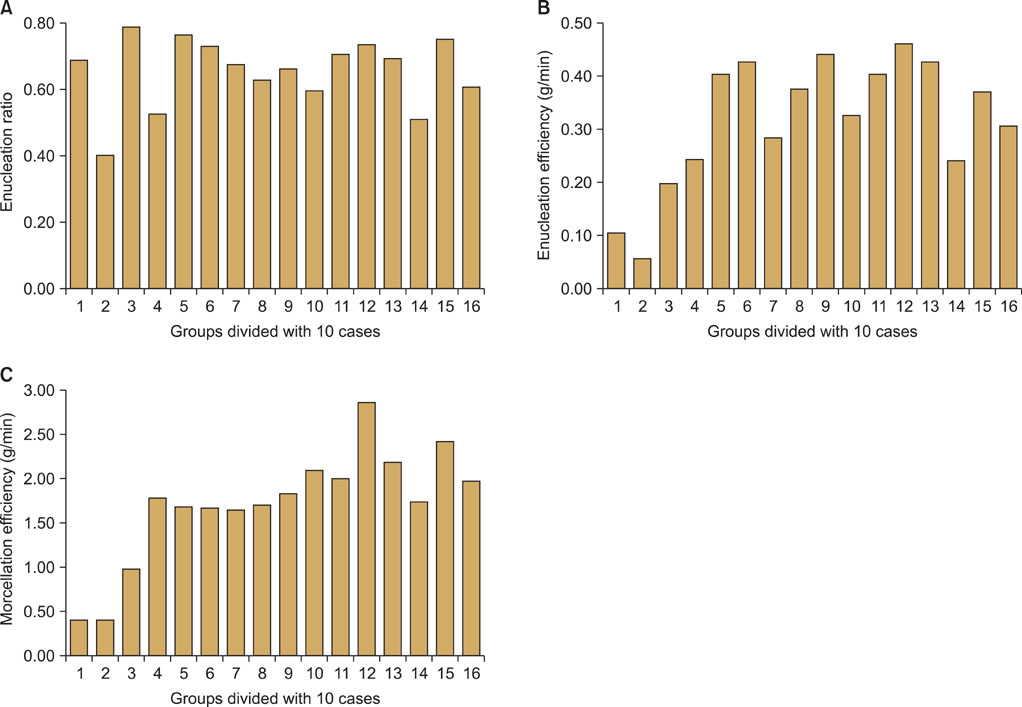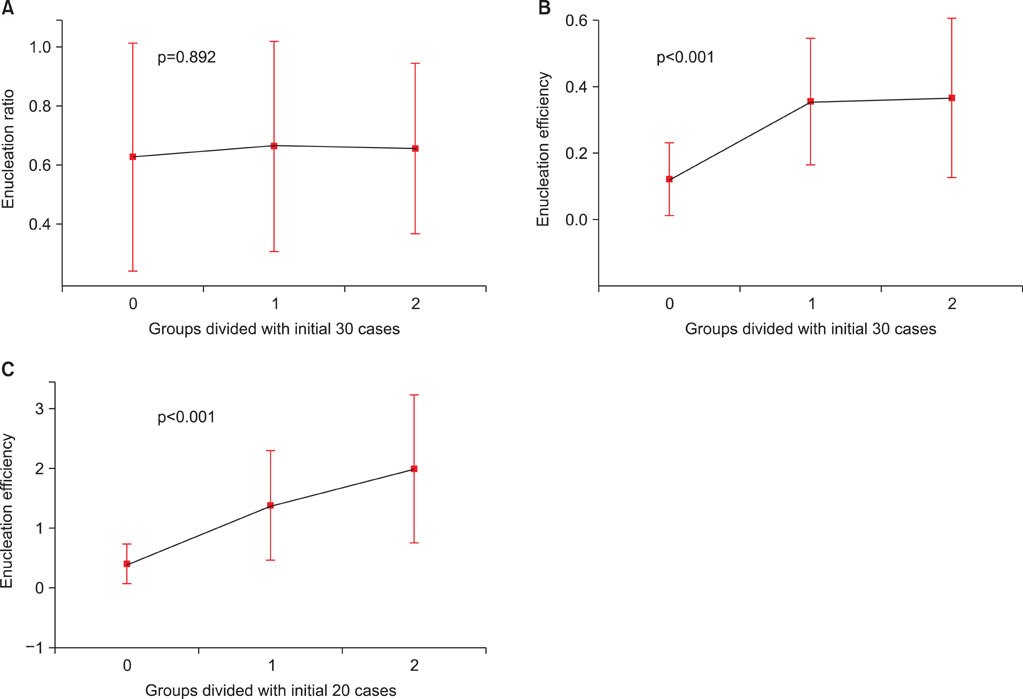Korean J Urol.
2010 Oct;51(10):688-693.
The Learning Curve for Holmium Laser Enucleation of the Prostate: A Single-Center Experience
- Affiliations
-
- 1Department of Urology, Seoul National University Hospital, Seoul, Korea. jspaick@snu.ac.kr
Abstract
- PURPOSE
Holmium laser enucleation of the prostate (HoLEP) is known to have a steep learning curve and, as a result, its clinical usage has limitations. The purpose of this study was to analyze the learning curve and early complications following the HoLEP procedure.
MATERIALS AND METHODS
A retrospective analysis was performed on 161 patients who had undergone the HoLEP procedure for lower urinary tract symptoms suggestive of benign prostatic hyperplasia (BPH) from July 2008 to September 2009. The procedure was done by two surgeons. Perioperatively, enucleated tissue weight, enucleation time, morcellation time, enucleation ratio (enucleation weight/transitional zone volume), and enucleation efficiency (enucleated weight/enucleation time) were analyzed, and early complications were assessed.
RESULTS
Mean enucleation time, morcellation time, and enucleation ratio were 61.3 min (range, 10-180 min), 12.3 min (range, 2-60 min), and 0.66 (range, 0.07-2.51), respectively. In terms of efficiency, enucleation efficiency was 0.32 g/min (range, 0.02-1.25 g/min) and morcellation efficiency was 1.73 g/min (range, 0.1-7.7 g/min). Concerning the learning curve, enucleation efficiency was stationary after 30 cases (p<0.001), morcellation efficiency reached a learning curve at 20 cases (p=0.032), and enucleation ratio had no learning curve in this study. There were several cases of surgery-related complications, including bladder mucosal injury by the morcellator (13%), capsular injury during enucleation (7%), and conversion to a conventional resectoscopy procedure (15%), which showed a reduction in incidence with time.
CONCLUSIONS
The learning curve of HoLEP is steep; however, it can be overcome gradually. Further study is necessary with respect to long-term postoperative follow-up.
Keyword
MeSH Terms
Figure
Reference
-
1. Chilton CP, Mundy IP, Wiseman O. Results of holmium laser resection of the prostate for benign prostatic hyperplasia. J Endourol. 2000. 14:533–534.2. Moody JA, Lingeman JE. Holmium laser enucleation for prostate adenoma greater than 100 gm: comparison to open prostatectomy. J Urol. 2001. 165:459–462.3. Westenberg A, Gilling P, Kennett K, Frampton C, Fraundorfer M. Holmium laser resection of the prostate versus transurethral resection of the prostate: results of a randomized trial with 4-year minimum long-term followup. J Urol. 2004. 172:616–619.4. Montorsi F, Naspro R, Salonia A, Suardi N, Briganti A, Zanoni M, et al. Holmium laser enucleation versus transurethral resection of the prostate: results from a 2-center, prospective, randomized trial in patients with obstructive benign prostatic hyperplasia. J Urol. 2004. 172:1926–1929.5. Kuntz RM, Lehrich K. Transurethral holmium laser enucleation versus transvesical open enucleation for prostate adenoma greater than 100 gm: a randomized prospective trial of 120 patients. J Urol. 2002. 168:1465–1469.6. Elzayat EA, Elhilali MM. Holmium laser enucleation of the prostate (HoLEP): the endourologic alternative to open prostatectomy. Eur Urol. 2006. 49:87–91.7. Gilling PJ, Cass CB, Malcolm AR, Fraundorfer MR. Combination holmium and Nd:YAG laser ablation of the prostate: initial clinical experience. J Endourol. 1995. 9:151–153.8. Gilling PJ, Kennett K, Das AK, Thompson D, Fraundorfer MR. Holmium laser enucleation of the prostate (HoLEP) combined with transurethral tissue morcellation: an update on the early clinical experience. J Endourol. 1998. 12:457–459.9. Shah HN, Mahajan AP, Sodha HS, Hegde S, Mohile PD, Bansal MB. Prospective evaluation of the learning curve for holmium laser enucleation of the prostate. J Urol. 2007. 177:1468–1474.10. Seki N, Mochida O, Kinukawa N, Sagiyama K, Naito S. Holmium laser enucleation for prostatic adenoma: analysis of learning curve over the course of 70 consecutive cases. J Urol. 2003. 170:1847–1850.11. Matlaga BR, Kim SC, Kuo RL, Watkins SL, Lingeman JE. Holmium laser enucleation of the prostate for prostates of > 125 mL. BJU Int. 2006. 97:81–84.12. Perlmutter AP, Schulsinger DA. The "Wedge" resection device for electrosurgical transurethral prostatectomy. J Endourol. 1998. 12:75–79.13. Herrell SD, Smith JA Jr. Robotic-assisted laparoscopic prostatectomy: what is the learning curve? Urology. 2005. 66:5 Suppl. 105–107.
- Full Text Links
- Actions
-
Cited
- CITED
-
- Close
- Share
- Similar articles
-
- Technical Aspects of Holmium Laser Enucleation of the Prostate for Benign Prostatic Hyperplasia
- Enucleated Weight/Enucleation Time, Is It Appropriate for Estimating Enucleation Skills for Holmium Laser Enucleation of the Prostate? A Consideration of Energy Consumption
- Current surgical techniques of enucleation in holmium laser enucleation of the prostate
- Holmium Laser Enucleation of the Prostate for Benign Prostatic Hyperplasia: Effectiveness, Safety, and Overcoming of the Learning Curve
- Comparison of Predictive Factors for Postoperative Incontinence of Holmium Laser Enucleation of the Prostate by the Surgeons' Experience During Learning Curve




